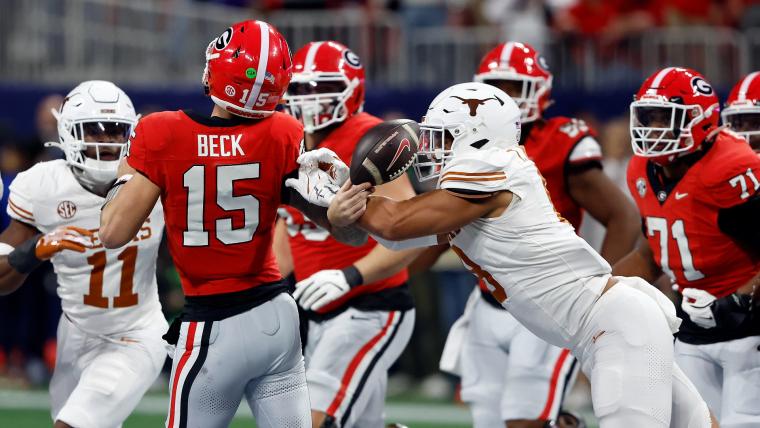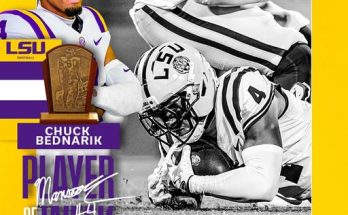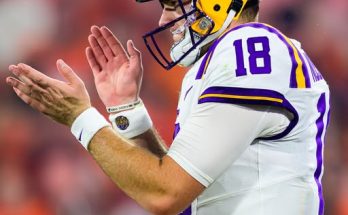The Rehabilitation Status of Miami Quarterback Carson Beck Following Shoulder Surgery
Carson Beck, the quarterback for the Miami football team, has been under the spotlight recently due to his shoulder surgery and subsequent rehabilitation process. As a pivotal player for the team, Beck’s health is of paramount importance to fans, coaches, and teammates alike. This article provides an in-depth look into the details surrounding Beck’s injury, the surgery he underwent, and the current status of his rehabilitation journey.
The Injury: A Turning Point in the Season
The season was progressing well for the Miami football team when disaster struck during a mid-season game. Beck suffered a significant injury to his throwing shoulder, which was initially suspected to be a strain but later diagnosed as a torn labrum. This diagnosis came after several weeks of persistent discomfort and limited mobility, despite Beck’s attempts to play through the pain. A torn labrum is a serious injury for any athlete, particularly for a quarterback whose performance heavily relies on arm strength, accuracy, and mobility.
Medical experts explained that the labrum is a ring of cartilage surrounding the shoulder socket, and its tear can severely impact shoulder stability and range of motion. For a quarterback, this translates into compromised throwing mechanics and increased susceptibility to further injuries. Given the severity of the injury, Beck and the Miami coaching staff decided that surgery was the best course of action, despite it meaning the end of his season.
The Surgery: A Strategic Intervention
In late November, Beck underwent arthroscopic shoulder surgery performed by a renowned orthopedic surgeon specializing in sports injuries. The procedure aimed to repair the torn labrum and address any associated damage to surrounding tissues. Arthroscopic surgery is minimally invasive, involving small incisions and the use of a camera-guided tool, which typically allows for quicker recovery times compared to traditional open surgery.
According to team medical staff, the surgery was successful, with no complications during the procedure. Post-surgery reports indicated that the labrum was securely repaired, and Beck’s shoulder was stabilized. However, as with any surgical intervention, the real test lies in the rehabilitation process and how well the patient responds to treatment.
Rehabilitation: A Multi-Phase Process
Rehabilitation for a torn labrum is a meticulous and multi-phased process, particularly for a high-performance athlete like Carson Beck. The Miami medical team and Beck’s personal trainers have outlined a comprehensive rehabilitation program tailored to his specific needs. The program is divided into four primary phases:
Phase 1: Immobilization and Pain Management
The first phase, which lasted for approximately six weeks post-surgery, focused on immobilizing the shoulder to allow the repaired tissues to heal. Beck’s arm was placed in a sling, and he was advised to avoid any movements that could strain the shoulder. Pain management during this period involved the use of prescribed medications, ice therapy, and rest.
Phase 2: Passive Range of Motion (PROM)
Once the initial healing period was complete, Beck transitioned to the second phase, which involved passive range-of-motion exercises. These exercises were performed under the guidance of a physical therapist, who ensured that the movements did not put undue stress on the repaired labrum. The goal during this phase was to gently restore mobility and prevent stiffness without compromising the surgical repair.
Phase 3: Active Range of Motion (AROM) and Strengthening
The third phase marked the beginning of active participation in rehabilitation. Beck started to perform exercises that actively engaged the shoulder muscles, focusing on rebuilding strength and improving range of motion. Resistance bands and light weights were introduced during this phase to gradually increase the load on the shoulder. Beck’s trainers also emphasized core strength and overall fitness, recognizing the importance of a well-rounded physical foundation for his return to play.
Phase 4: Functional and Sport-Specific Training
Currently, Carson Beck is in the fourth and most critical phase of his rehabilitation. This phase involves functional and sport-specific training aimed at preparing him for the demands of professional football. Beck has been working on throwing mechanics, footwork, and shoulder stability under the supervision of a team of experts. Advanced technologies, such as motion capture systems and wearable sensors, are being used to analyze his movements and ensure that his mechanics are efficient and safe.
Moreover, Beck is participating in simulated game scenarios to regain his confidence and reacquaint himself with the physical and mental demands of the game. These sessions are designed to test his shoulder under conditions that closely mimic the intensity of actual gameplay. The team’s coaching staff has been closely monitoring his progress, providing feedback to fine-tune his performance.
Timeline for Return
The typical recovery timeline for a torn labrum is approximately six to nine months, depending on the severity of the injury and the individual’s response to rehabilitation. For Carson Beck, the timeline appears to be on track, with early indications suggesting that he could be ready to return to practice by the start of the next season’s training camp.
Beck’s rehabilitation progress has been described as “encouraging” by Miami’s head coach, who praised the quarterback’s work ethic and determination. The team’s medical staff has also expressed optimism, noting that Beck’s recovery is proceeding without any significant setbacks. However, they remain cautious, emphasizing the importance of not rushing the process to avoid re-injury.
Mental and Emotional Resilience
Rehabilitation is not only a physical journey but also a mental and emotional one. For Beck, the months away from the field have been challenging but transformative. In interviews, he has spoken candidly about the frustration of being sidelined and the determination to come back stronger.
To support his mental well-being, Beck has been working with a sports psychologist who specializes in injury recovery. These sessions have focused on building resilience, managing expectations, and maintaining a positive outlook. Additionally, Beck has stayed engaged with the team by attending meetings, reviewing game footage, and mentoring younger players. This involvement has kept him connected to the sport and reinforced his leadership role within the team.
Future Prospects
As Carson Beck nears the final stages of his rehabilitation, the focus shifts to his potential impact on the Miami football team’s future. Beck has already demonstrated exceptional talent and leadership during his time as the starting quarterback, and a successful recovery could elevate his game to new heights. The team’s coaching staff is eager to see him back on the field, where his skills, experience, and determination will undoubtedly play a crucial role in their success.
Beyond the team, Beck’s recovery has also drawn attention from NFL scouts and analysts, who view him as a promising prospect for the professional league. A strong comeback season could significantly enhance his draft stock and pave the way for a successful career at the next level.
Conclusion
The rehabilitation status of Miami quarterback Carson Beck following shoulder surgery is a testament to the power of determination, meticulous planning, and expert medical care. While the journey has been arduous, Beck’s progress underscores the resilience and commitment required to overcome such a significant setback. As he continues to work towards a full recovery, the anticipation for his return grows among fans and teammates alike. With his eyes set on the future, Carson Beck remains a symbol of hope and perseverance, ready to make his mark once again on the football field.



